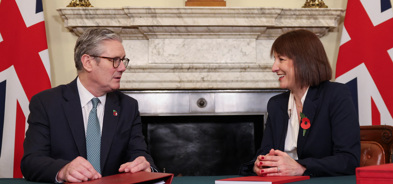Coronavirus: everything that can be done will be done to help businesses
In the face of the virus threat, the measures adopted by governments and central banks are impressive and unprecedented, says Chris Godding
The value of investments can fall as well as rise and that you may not get back the amount you originally invested.
Nothing in these briefings is intended to constitute advice or a recommendation and you should not take any investment decision based on their content.
Any opinions expressed may change or have already changed.
Written by Chris Godding
Published on 25 Mar 20206 minute read

Last month, the subtitle of this piece suggested that equity markets could fall 20% in a global pandemic scenario, but that lower interest rates would soften the blow and help make for a swift recovery.
What has happened so far is that the MSCI World is down 34% in US dollar terms and the MSCI UK has fallen around 32%.
On 3 March, post an emergency meeting of the G7, the US Federal Reserve cut interest rates by 0.5%, but a week later equities had fallen 6%.
On 15 March, the Fed cut again by 1%, leaving the interest rate band at an all-time low of 0-0.25%. The Bank of England also cut rates to 0.1%, but equities continued to decline another 15%.
Clearly, just cutting rates was not enough and in those three weeks there were four days when equities moved by more than 8% as volatility spiked to 82.7%, surpassing the record level seen in November 2008.
Needless to say, the price volatility we have seen across all asset classes in the last month has been extraordinary as investors grappled to find a foundation to rely on. The Coronavirus infects confidence just as effectively as it does people. To find stability, we need liquidity for assets to trade effectively, a reasonable estimate of the size of the problem and some measure of potential duration. With all three missing, it is no surprise that markets began to be dysfunctional and finding a rational price level became virtually impossible.
Providing liquidity is not a panacea, but helps
In the face of this challenge, our institutions of government and Central banks have also responded in an unprecedented and impressive manner. The US Federal Reserve, the European Central Bank, the Bank of England, the Bank of Japan and the Peoples’ Bank of China, along with a host of smaller Central banks, have intervened to restore liquidity with unlimited firepower as well as implementing purchase programmes to alleviate stress in a wide range of assets.
When the real question is solvency, providing liquidity is not a panacea, but it definitely helps for a Central bank to have your back. With a list of policies that would run to many pages if listed in this note, multiple governments around the world have also responded to ease concerns regarding solvency as well as liquidity. Fiscal expediency has given way to fiscal expansion on a scale that is hard to comprehend – but the message is clear enough. Everything that can be done will be done to help businesses cross the economic chasm created by the virus because, if a business can survive long enough, it will thrive again.
These actions are not enough to eliminate a recession, but they will ameliorate its extent, form the basis for recovery and provide investors with a little more clarity.
The remaining leg of this three-legged recovery stool is the duration.
The Coronavirus infects confidence just as effectively as it does people
The effectiveness of the measures
This will also inevitably influence the depth of the slowdown and is where containment and our personal freedoms play a part. We have seen what can be done by looking to the actions taken in China and this provides a base case to work from. China has not escaped unscathed from the economic impact of the virus, but as a result of the success of containment, Chinese equities are virtually unchanged. The policy response has stopped the growth of infections and restored confidence.
In my opinion, the degree of deviation from the China framework will determine the duration and depth of this crisis around the world. Complacency is dangerous and while Europe now appears to be firmly on the China track, the uncoordinated response in the US suggests that it is too early to declare the end of the beginning.
Even assuming that Congress agree on a fiscal spending bill – expected to be in excess of US$2 trillion – a reliance on fiscal and monetary policy alone is insufficient. It must be combined with containment. The Fed’s printing press will definitely help anesthetise the patient but all three remedies are required for a cure.
My message is that the monetary policy response to resolve the liquidity issues is sufficient enough to reduce volatility and restore functional markets. The fiscal response is also adequate within the context of a short sharp shock.
Given the magnitude of the impact on activity, the length of the downturn is critical. It largely depends on containment and I believe confidence will recover once the mist lifts on the duration. For the moment, using estimated earnings to pick a bottom or value a company is largely worthless but long-term cash-flows and book value can provide some comfort to analysts looking for bargains. However, confidence is the key and once it turns, the potential for a recovery in markets, given the fiscal and monetary stimulus, is like water behind a dam. Some of the major pieces to restore it are in place but their efficacy can only cover a limited period and will fail without the appropriate controls on movement and contact.
In 2019, the GDP of the US was approximately US$21.4 trillion and therefore the proposed fiscal package being debated in Congress equates to an impressive 10% of GDP.
However, if output falls by 50% in one quarter during this crisis, this huge fiscal injection will buy just 74 days. China went into lock down at the end of Chinese New Year and is now beginning to relax controls.
With the draconian policies they put in place, it took 60 days to arrest the spread of infections which suggests there is a minimal margin for procrastination in the US.
If a business can survive long enough, it will thrive again
Future scenarios: Tilney's view
I expect markets to begin recovering on a regional basis once the growth rate of infections stabilises and well before freedom of movement is completely restored. The experience in China suggests this can be achieved within just 30 days of the appropriate controls being in place. European markets should see the benefits relatively soon thanks to the actions taken to date while President Trump is suggesting a return to work as soon as Easter. We are all learning in these challenging times and he may be right, but the evidence suggests that a stitch in time saves nine.
Given the falls we have seen in equities and, assuming the appropriate response is in place, I urge clients to look at the equity risk in their portfolios and open a discussion with their adviser with a view to the next ten years. We have limited visibility in the short term; volatility is likely to remain elevated and further losses are certainly possible.
However, with the current fiscal and monetary stimulus, the recovery potential of financial assets – in nominal terms at least – is material compared to our estimate of the remaining downside risk.
Tilney as a firm reacted very quickly to reorganise for the current operating conditions.
Our systems and people are working remarkably well and the extraordinary individual contributions have been inspiring to see. While in our own small way, we are doing what we can to maintain a normal service to our clients, we are humbled by the heroic efforts of staff of the NHS and the other emergency services.
Please don’t hesitate to contact us on 020 7189 9999 if you have any questions and, most importantly, stay safe.
Get insights and events via email
Receive the latest updates straight to your inbox.
You may also like…


Market news
2024 Autumn Budget Overview: The key announcements from Chancellor Rachel Reeves




